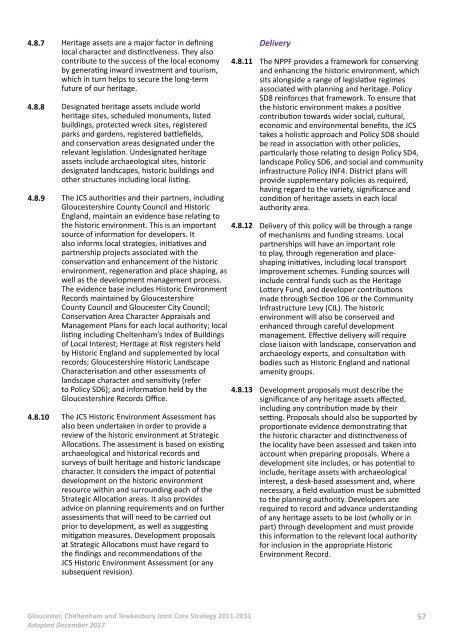JCS_MasterDocument_FIN_27.03.18
You also want an ePaper? Increase the reach of your titles
YUMPU automatically turns print PDFs into web optimized ePapers that Google loves.
4.8.7<br />
4.8.8<br />
4.8.9<br />
4.8.10<br />
Heritage assets are a major factor in defining<br />
local character and distinctiveness. They also<br />
contribute to the success of the local economy<br />
by generating inward investment and tourism,<br />
which in turn helps to secure the long-term<br />
future of our heritage.<br />
Designated heritage assets include world<br />
heritage sites, scheduled monuments, listed<br />
buildings, protected wreck sites, registered<br />
parks and gardens, registered battlefields,<br />
and conservation areas designated under the<br />
relevant legislation. Undesignated heritage<br />
assets include archaeological sites, historic<br />
designated landscapes, historic buildings and<br />
other structures including local listing.<br />
The <strong>JCS</strong> authorities and their partners, including<br />
Gloucestershire County Council and Historic<br />
England, maintain an evidence base relating to<br />
the historic environment. This is an important<br />
source of information for developers. It<br />
also informs local strategies, initiatives and<br />
partnership projects associated with the<br />
conservation and enhancement of the historic<br />
environment, regeneration and place shaping, as<br />
well as the development management process.<br />
The evidence base includes Historic Environment<br />
Records maintained by Gloucestershire<br />
County Council and Gloucester City Council;<br />
Conservation Area Character Appraisals and<br />
Management Plans for each local authority; local<br />
listing including Cheltenham’s Index of Buildings<br />
of Local Interest; Heritage at Risk registers held<br />
by Historic England and supplemented by local<br />
records; Gloucestershire Historic Landscape<br />
Characterisation and other assessments of<br />
landscape character and sensitivity (refer<br />
to Policy SD6); and information held by the<br />
Gloucestershire Records Office.<br />
The <strong>JCS</strong> Historic Environment Assessment has<br />
also been undertaken in order to provide a<br />
review of the historic environment at Strategic<br />
Allocations. The assessment is based on existing<br />
archaeological and historical records and<br />
surveys of built heritage and historic landscape<br />
character. It considers the impact of potential<br />
development on the historic environment<br />
resource within and surrounding each of the<br />
Strategic Allocation areas. It also provides<br />
advice on planning requirements and on further<br />
assessments that will need to be carried out<br />
prior to development, as well as suggesting<br />
mitigation measures. Development proposals<br />
at Strategic Allocations must have regard to<br />
the findings and recommendations of the<br />
<strong>JCS</strong> Historic Environment Assessment (or any<br />
subsequent revision).<br />
4.8.11<br />
4.8.12<br />
4.8.13<br />
Delivery<br />
The NPPF provides a framework for conserving<br />
and enhancing the historic environment, which<br />
sits alongside a range of legislative regimes<br />
associated with planning and heritage. Policy<br />
SD8 reinforces that framework. To ensure that<br />
the historic environment makes a positive<br />
contribution towards wider social, cultural,<br />
economic and environmental benefits, the <strong>JCS</strong><br />
takes a holistic approach and Policy SD8 should<br />
be read in association with other policies,<br />
particularly those relating to design Policy SD4,<br />
landscape Policy SD6, and social and community<br />
infrastructure Policy INF4. District plans will<br />
provide supplementary policies as required,<br />
having regard to the variety, significance and<br />
condition of heritage assets in each local<br />
authority area.<br />
Delivery of this policy will be through a range<br />
of mechanisms and funding streams. Local<br />
partnerships will have an important role<br />
to play, through regeneration and placeshaping<br />
initiatives, including local transport<br />
improvement schemes. Funding sources will<br />
include central funds such as the Heritage<br />
Lottery Fund, and developer contributions<br />
made through Section 106 or the Community<br />
Infrastructure Levy (CIL). The historic<br />
environment will also be conserved and<br />
enhanced through careful development<br />
management. Effective delivery will require<br />
close liaison with landscape, conservation and<br />
archaeology experts, and consultation with<br />
bodies such as Historic England and national<br />
amenity groups.<br />
Development proposals must describe the<br />
significance of any heritage assets affected,<br />
including any contribution made by their<br />
setting. Proposals should also be supported by<br />
proportionate evidence demonstrating that<br />
the historic character and distinctiveness of<br />
the locality have been assessed and taken into<br />
account when preparing proposals. Where a<br />
development site includes, or has potential to<br />
include, heritage assets with archaeological<br />
interest, a desk-based assessment and, where<br />
necessary, a field evaluation must be submitted<br />
to the planning authority. Developers are<br />
required to record and advance understanding<br />
of any heritage assets to be lost (wholly or in<br />
part) through development and must provide<br />
this information to the relevant local authority<br />
for inclusion in the appropriate Historic<br />
Environment Record.<br />
Gloucester, Cheltenham and Tewkesbury Joint Core Strategy 2011-2031<br />
Adopted December 2017<br />
57




